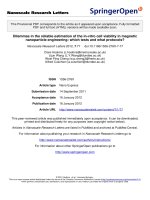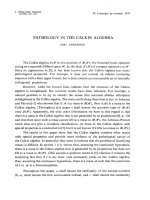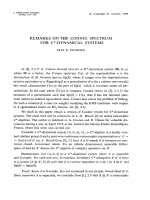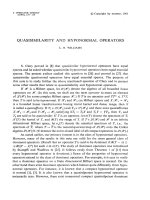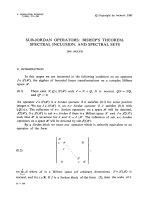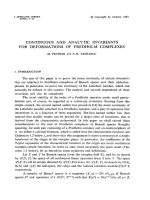Báo cáo toán học: "Triangulations and the Haj´s Conjecture " ppt
Bạn đang xem bản rút gọn của tài liệu. Xem và tải ngay bản đầy đủ của tài liệu tại đây (96.76 KB, 7 trang )
Triangulations and the Haj´os Conjecture
Bojan Mohar
∗
Department of Mathematics,
University of Ljubljana,
1000 Ljubljana, Slovenia
Submitted: Apr 18, 2005; Accepted: Sep 1, 2005; Published: Sep 14, 2005
Mathematics Subject Classifications: 05C10, 05C15
Abstract
The Haj´os Conjecture was disproved in 1979 by Catlin. Recently, Thomassen
showed that there are many ways that Haj´os conjecture can go wrong. On the other
hand, he observed that locally planar graphs and triangulations of the projective
plane and the torus satisfy Haj´os Conjecture, and he conjectured that the same
holds for arbitrary triangulations of closed surfaces. In this note we disprove the
conjecture and show that there are different reasons why the Haj´os Conjecture fails
also for triangulations.
1 Introduction
Haj´os conjecture claims that every graph whose chromatic number is at least k contains
a subdivision of K
k
, the complete graph of order k. The conjecture has been proved for
k ≤ 4 by Dirac [3], while for k = 5, it yields a strengthening of the Four Color Theorem,
which is still open. The conjecture was disproved for all k ≥ 7 by Catlin [2]. Soon after
that, Erd˝os and Fajtlowicz [4] proved that the conjecture is false for almost all graphs.
Recently, Thomassen [11] revived the interest in Haj´os conjecture by showing that
there is a great variety of reasons why Haj´os conjecture can be wrong. At the end
of this interesting work, Thomassen observed that the Haj´os conjecture could be true
to some limited extent. Maybe it holds in the setting under whose influence it was
originally formulated (related to the Four Color Conjecture). For instance, it holds for
graphs embedded in any fixed surface with sufficiently large edge-width (i.e., when all
noncontractible cycles are long). Therefore, it seems plausible to propose:
∗
Supported in part by the Ministry of Education, Science and Sport of Slovenia, Research Project
J1-0502-0101 and Research Program P1-0297.
the electronic journal of combinatorics 12 (2005), #N15 1
Conjecture 1.1 (Thomassen [11]) Every graph that triangulates some surface satisfies
Haj´os conjecture.
Every n-vertex triangulation of a nonplanar surface has at least 3n −3 edges. There-
fore, it contains a subdivision of K
5
by a theorem of Mader [6]. In particular, possible
counterexamples to Conjecture 1.1 must have chromatic number at least 6. Thomassen
[11] used a known list of 6- and 7-critical graphs on the projective plane and the torus
[10] to prove that Conjecture 1.1 holds for triangulations on these two surfaces.
In this note we provide counterexamples to Conjecture 1.1. Additionally, we give
some reasons showing that, in certain sense, almost all graphs should be close to some
counterexamples.
2 A small counterexample
Let
˜
H be the graph with vertex set
V = {v
i,j
| 0 ≤ i ≤ 4, 0 ≤ j ≤ 2}∪{w
i
| 0 ≤ i ≤ 4}
in which distinct vertices v
i,j
and v
k,l
are adjacent if and only if k ∈{i −1,i,i+1} (where
i − 1andi + 1 are taken modulo 5), and w
i
is adjacent to all vertices v
i,j
and v
i+1,j
,
0 ≤ j ≤ 2. In other words,
˜
H is composed of 5 copies Q
i
(0 ≤ i ≤ 4) of the graph K
7
with vertices C
−
i
= {v
i,0
,v
i,1
,v
i,2
}, C
+
i
= {v
i+1,0
,v
i+1,1
,v
i+1,2
},andw
i
,andC
+
i
⊂ Q
i
is
identified with C
−
i+1
⊂ Q
i+1
for 0 ≤ i ≤ 4 (indices modulo 5).
The graph
˜
H is a counterexample to Conjecture 1.1:
Theorem 2.1 The graph
˜
H triangulates the orientable surface of genus 6 and the nonori-
entable surface of genus 12. Its chromatic number is 8 and it does not contain a subdivision
of K
8
.
C
-
C
+
0
0
1
1
2
2 2
3
3
4
4
5
5
6
6
0
Figure 1: K
7
on the torus
Proof. The graph K
7
triangulates the torus. See Figure 1, where the edge on the
left is identified with the rightmost one, and the two cycles of the resulting cylinder are
then identified as shown by the labels. Consider 5 such triangulations using Q
0
, ,Q
4
.
We may assume that the triangles C
+
i
and C
−
i
of each Q
i
are facial; suppose that they
correspond to the triangles that are labeled 023 and 156 in Figure 1. By identifying C
+
i
the electronic journal of combinatorics 12 (2005), #N15
2
with C
−
i+1
for i =0, 1, 2, 3, we obtain the connected sum of five tori. Finally, by identifying
C
+
4
with C
−
0
, the orientable surface of genus 6 is obtained. Clearly, the resulting graph
is isomorphic to
˜
H and triangulates the surface. Instead of the orientable surface we can
get a nonorientable surface of the same Euler characteristic by taking for C
−
0
in Q
0
the
triangle 165 instead of 156.
Let H be the subgraph of
˜
H obtained by removing vertices w
0
, ,w
4
. Clearly, no
three vertices of H are independent. Thus, χ(H) ≥|V (H)|/2 = 8. Also, it is easy
to find an 8-coloring of H, and any such coloring extends to
˜
H since the degrees of the
removed vertices w
i
are equal to 6. Consequently, χ(
˜
H)=χ(H)=8.
Let us now prove that
˜
H does not contain a subdivision of K
8
. Assume, by reductio ad
absurdum, that L ⊆
˜
H is such a subgraph. Vertices of degree 7 in L are branch vertices;
vertices of degree 2 subdivide edges of K
8
.Sincedeg
˜
H
(w
i
)=6,now
i
is a branch vertex.
Since the neighbors of w
i
form a complete subgraph, we may also assume that w
i
does
not subdivide an edge in L for i =0, ,4. In particular, we conclude that L ⊆ H.
Let B ⊆ V (L) be the set of branch vertices and let s be the number of vertices of
degree 2 in L. Clearly, |B| =8ands ≤|V (H) \ B| =7. LetB
i
= B ∩ C
+
i
and b
i
= |B
i
|
for 0 ≤ i ≤ 4. We may assume that b
0
=max
i
b
i
and that, subject to this assumption,
b
0
+ b
1
is maximum. Then it is easy to see that (b
0
,b
1
) ∈{(3, 3), (3, 2), (3, 1), (2, 2)}.We
let b = b
0
+ b
1
.
There are 8 −b branch vertices that need to be joined to b branch vertices in B
0
∪B
1
.
Each such vertex x ∈ B
2
∪ B
3
∪ B
4
is linked to all vertices in B
0
∪ B
1
;someofthe
subdivided edges must contain two or three vertices of degree 2. It is easy to see that for
every such x, at least four vertices of degree 2 are needed, with two possible exceptions
in the cases when b
0
= b
1
=2orb
0
=3,b
1
= 1. In any case, we conclude that s ≥ 8, and
this contradiction completes the proof.
3 Paley graphs
Let q = p
r
be a prime power, where p ≡ 1(mod4).ThePaley graph P
q
is the Cayley
graph of the additive group of the finite field GF (q) generated by all squares, i.e., V (P
q
)=
GF (q) and two distinct vertices x, y are adjacent if and only if x − y = z
2
for some
z ∈ GF(q). Since p ≡ 1(mod4),x − y is a square if and only if y − x is a square, and
this assures that P
q
is a graph and not a digraph.
Paley graphs have a number of intriguing properties. First of all, they are highly
symmetric. Secondly, they are self-complementary. On the other hand, they resemble
random graphs a lot. One of their properties which makes them similar to random graphs
is the following result of Thomason [9]; see also [1, p. 363].
Theorem 3.1 Let A be a set of vertices of the Paley graph P
q
.Leta = |A|, and let e(A)
be the number of edges in the induced subgraph P
q
(A). Then
e(A) −
1
2
a
2
≤
a(q − a)
4
√
q
.
the electronic journal of combinatorics 12 (2005), #N15 3
This theorem implies that the maximum clique in P
q
has at most
√
q vertices. Equality
is attained if q is an even power of a prime. But if q is a prime, it seems that the
maximum cliques in P
q
have far smaller orders. It is believed that their orders are at
most polylogarithmic, possibly o(log
2
q) or even smaller. See [1] for some discussion on
this problem.
Let z be a generator of the multiplicative group GF (q)
∗
. It is known that this group
is cyclic, so z
0
,z
2
,z
4
, ,z
q−3
are precisely all squares. For each vertex x ∈ V (P
q
), its
neighbors are x + z
0
,x+ z
2
,x+ z
4
, ,x+ z
q−3
. This (cyclic) sequence defines a local
rotation around x, i.e., a clockwise cyclic order of edges incident with x. The collection
of all such local rotations defines an orientable embedding Π
q
of P
q
which is known as the
Paley map. It has the following properties (see [12]):
Theorem 3.2 Suppose that q = p
r
, where p ≡ 1(mod8)is a prime. Then the Paley
map Π
q
is self-dual – the geometric dual graph P
∗
q
is isomorphic to P
q
. Its genus is equal
to (q
2
−9q +8)/8. It has q faces, each of which has length (q −1)/2 and is bounded by a
cycle of P
q
.
We refer to [12] for more details concerning this interesting map.
From now on we assume that q ≡ 1 (mod 8). Let T
q
be the triangulation of the
orientable surface of genus (q
2
− 9q +8)/8 obtained from the Paley map Π
q
by adding a
new vertex into each face and joining it to all vertices on the boundary of that face. Let
V
q
= V (P
q
)andletV
∗
q
be the added vertices. Then |V
q
| = |V
∗
q
| = q.
Theorem 3.3 Suppose that q = p
r
, where p ≡ 1(mod8)is a prime. The triangulation
T
q
contains no subdivision of the complete graph of order ≥ λ
√
q, where λ =
1
4
(2+
√
198) <
4.0178.
Proof. Let s =
√
q and k = λs. Suppose that T
q
contains a subdivision K of K
k
.
Let B
0
⊆ V (K) be the set of branch vertices, and let b = |B
0
∩ V
q
| and b
∗
= |B
0
∩ V
∗
q
|.
Clearly, b + b
∗
= k.
Let us count the number of subdivided edges in K. Since no two vertices in V
∗
q
are
adjacent, B
0
∩V
∗
q
gives rise to
b
∗
2
subdivided edges. Concerning the set B
0
∩V
q
,Theorem
3.1 shows that this set gives rise to at least
1
2
b
2
−
b(q−b)
4s
subdivided edges. Since the total
number of vertices of T
q
is equal to 2q,weseethat:
k +
b
∗
2
+
1
2
b
2
−
b(q − b)
4s
≤ 2q. (1)
Let b
∗
= α
∗
s and b = αs. Then (1) expands to the following condition
s(2α
∗
2
+ α
2
− α −8) + 2α
∗
+3α + α
2
≤ 0. (2)
Let Λ = α
∗
+ α. Then (2) implies that
2(Λ − α)
2
+ α
2
− α −8 < 0. (3)
the electronic journal of combinatorics 12 (2005), #N15 4
By considering (3) as a quadratic inequality in α, its discriminant is 97 + 8Λ − 8Λ
2
.
Therefore, (3) has no solutions if
8Λ
2
− 8Λ − 97 ≥ 0. (4)
Since Λs = k = λs≥λs,wehaveΛ≥ λ =
1
4
(2 +
√
198). This implies (4) and proves
that (3) has no solution. This contradiction completes the proof.
Theorem 3.3 now implies:
Theorem 3.4 Suppose that q = p
r
, where p ≡ 1(mod8)is a prime. If the chromatic
number of P
q
is at least λ
√
q, where λ =
1
4
(2 +
√
198), then the triangulation T
q
fails to
satisfy the Haj´os Conjecture.
In the above theorem, it suffices to assume that χ(T
q
) ≥ λ
√
q. But since the vertex
set V
∗
q
is independent in T
q
, χ(T
q
) ≤ χ(P
q
) + 1. Therefore, we find it more pleasing to use
the natural value χ(P
q
).
The independence numbers α(P
q
) of Paley graphs of prime order q less than 7000 were
computed by Shearer [8]. Using these calculations and estimate the chromatic number
by χ(P
q
) ≥q/α(P
q
), one finds out that Theorem 3.4 can be applied for many values of
q (and when q gets large, almost all of them are good). All such primes q ≤ 7000 with
q ≡ 1 (mod 8) are collected in Table 1.
As stated after Theorem 3.1, it is believed that for every prime q, ω(P
q
)=o(
√
q). If
true, this yields infinitely many cases where Theorem 3.4 can be applied.
4 Conclusions
We have proved that there is a variety of reasons why a triangulation of some surface may
fail to satisfy the Haj´os Conjecture. In this sense, this note can be viewed as an echo to
the stimulating work of Thomassen [11]. As noted in that paper, graphs embedded in
a surface Σ with sufficiently large edge-width satisfy the Haj´os Conjecture. Recall that
the edge-width of a graph embedded in a nonplanar surface is the length of a shortest
noncontractible cycle. In the above observation of Thomassen, the required width depends
on Σ. However, the following strengthening may be true:
Conjecture 4.1 There is an absolute constant w
0
such that every graph which can be
embedded in some surface with edge-width at least w
0
satisfies the Haj´os Conjecture.
K¨uhn and Osthus [5] proved that graphs whose girth is at least 186 satisfy the Haj´os
conjecture. This excludes the most obvious possibility of counterexamples to Conjecture
4.1. (Note that the edge-width of a graph of girth g is at least g.)
We do not dare to estimate what the best possible value for w
0
may be. However, if
we restrict ourselves to triangulations, no counterexamples of edge-width 4 are known.
the electronic journal of combinatorics 12 (2005), #N15 5
q α(P
q
) q/α(P
q
)λ
√
q
3697 15 247 245
4217 15 282 261
4441 15 297 268
4457 15 298 269
4649 17 274 274
4673 17 275 275
4721 17 278 277
4729 17 279 277
4793 16 300 279
4817 17 284 279
4937 17 291 283
4969 17 293 284
4993 17 294 284
5081 17 299 287
5153 17 304 289
5233 17 308 291
5281 17 311 292
5297 17 312 293
5393 17 318 296
5441 17 321 297
5449 17 321 297
5569 18 310 300
5657 18 315 303
5737 17 338 305
5801 17 342 307
5849 17 345 308
5857 17 345 308
5881 19 310 309
5897 17 347 309
q α(P
q
) q/α(P
q
)λ
√
q
5953 17 351 310
6073 19 320 314
6089 17 359 314
6113 19 322 315
6121 18 341 315
6217 19 328 317
6257 19 330 318
6329 19 334 320
6337 17 373 320
6353 17 374 321
6361 18 354 321
6449 19 340 323
6473 19 341 324
6481 17 382 324
6529 17 385 325
6553 19 345 326
6569 19 346 326
6577 19 347 326
6673 19 352 329
6689 19 353 329
6737 18 375 330
6761 20 339 331
6793 19 358 332
6833 19 360 333
6841 17 403 333
6857 17 404 333
6961 19 367 336
6977 18 388 336
Table1:Somegoodvaluesofq
Problem 4.2 Does every triangulation without noncontractible triangles satisfy the Haj´os
Conjecture?
For a graph H and a positive integer t,let
˜
H
t
be the graph obtained from the union
of H and the clique K
t
by adding all edges between them. Clearly, the Haj´os Conjecture
holds for H if and only if it holds for
˜
H
t
.
Let v and e (˜v and ˜e) be the number of vertices and edges of H (and
˜
H
t
), respectively.
Clearly, ˜v = v + t and ˜e = e +
t
2
+ vt.If
˜
H
t
triangulates some surface, then Euler’s
formula implies that ˜e is divisible by 3. This holds if and only if one of the following
holds:
the electronic journal of combinatorics 12 (2005), #N15 6
(A) e ≡ 0(mod3)andt ≡ 0(mod3),
(B) v + e ≡ 0(mod3)andt ≡ 1(mod3),or
(C) e −v ≡ 2(mod3)andt ≡ 2(mod3).
Conjecture 4.3 For every graph H, there exists a constant t
0
such that for every t ≥ t
0
for which one of (A)–(C) is satisfied, the graph
˜
H
t
triangulates some surface.
Conjecture 4.3 would imply that for every counterexample H to the Haj´os Conjecture
for which either e ≡ 0(mod3),v + e ≡ 0(mod3),ore − v ≡ 2 (mod 3), there are
infinitely many triangulations of the form
˜
H
t
which violate the Haj´os Conjecture.
Conjecture 4.3 would follow from a solution of a more general open problem which
has been raised in [7, Problem 4.4.10]:
Problem 4.4 Is there an ε>0 such that every graph of order n,withe edges, where e
is divisible by 3, and with minimum degree at least (1 −ε)n triangulates some surface?
A positive answer to Problem 4.4 would imply that almost one third of random graphs
in G(n, p), where p>1−ε, would be graphs of some triangulations. As shown by Erd˝os and
Fajtlowicz [4], almost all of these graphs would also be counterexamples to Conjecture 1.1.
References
[1] B. Bollob´as, Random graphs, 2
nd
ed., Cambridge University Press, Cambridge, 2001.
[2] P. Catlin, Haj´os’ graph-coloring conjecture: variations and counterexamples, J. Com-
bin. Theory, Ser. B 26 (1979) 268–274.
[3] G. A. Dirac, A property of 4-chromatic graphs and some remarks on critical graphs,
J. London Math. Soc. 27 (1952) 85–92.
[4] P. Erd˝os, S. Fajtlowicz, On the conjecture of Haj´os, Combinatorica 1 (1981) 141–143.
[5] D. K¨uhn, D. Osthus, Topological minors in graphs of large girth, J. Combin. Theory,
Ser. B 86 (2002) 364–380.
[6] W. Mader, 3n − 5 edges do force a subdivision of K
5
, Combinatorica 18 (1998)
569–595.
[7] B. Mohar and C. Thomassen, Graphs on Surfaces, Johns Hopkins University Press,
Baltimore, 2001.
[8] J. B. Shearer, />[9] A. G. Thomason, Paley graphs and Weil’s theorem, Talk at the British Combinatorial
Conference, Southampton, 1983 (unpublished).
[10] C. Thomassen, Five-coloring graphs on the torus, J. Combin. Theory Ser. B 62 (1994)
11–33.
[11] C. Thomassen, Some remarks on Haj´os’ conjecture, J. Combin. Theory, Ser. B 93
(2005) 95–105.
[12] A. T. White, Graphs of groups on surfaces. Interactions and models, North-Holland,
Amsterdam, 2001.
the electronic journal of combinatorics 12 (2005), #N15 7



